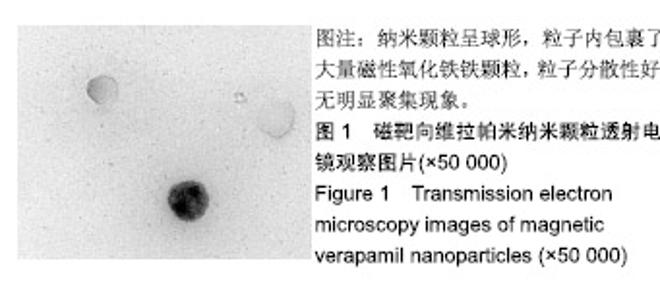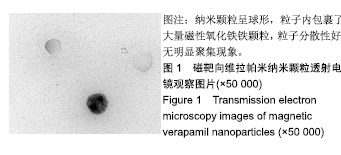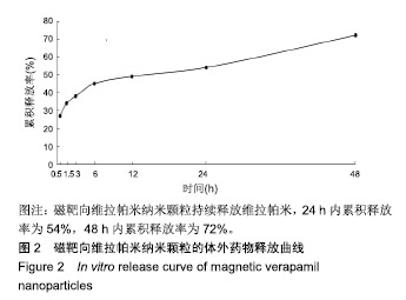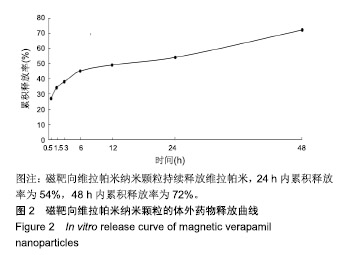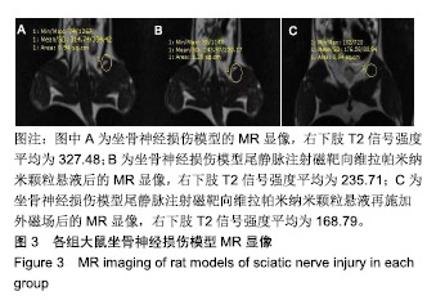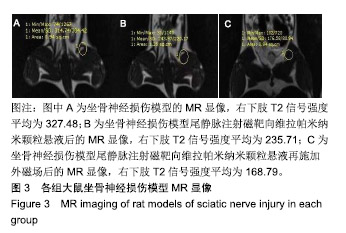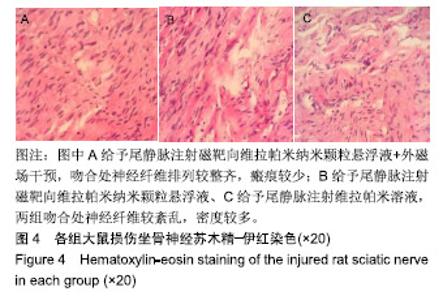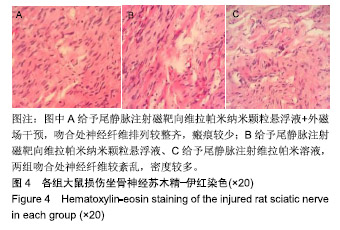| [1]Scheib J,Hoke A.Advances in peripheral nerve regeneration.Nat Rev Neurol.2013;9(12):668-676.[2]Ladak A,Olson J,Tredget EE,et al.Differentiation of mesenchymal stem cells to support peripheral nerve regeneration in a rat model. Exp Neurol.2011;228(2):242-252.[3]Teodori RM,Silva AM,Silva MT,et al.High-voltage electrical stimulation improves nerve regeneration after sciatic crush injury. Rev Bras Fisioter.2011;15(4):325-331. [4]Haastert K,Lipokatic E,Fischer M,et al.Differentially promoted peripheral nerve regeneration by grafted Schwann cells over- expressing different FGF-2 isoforms.Neurobiol Dis. 2006;21(1): 138-153. [5]Takemura Y,Imai S, Kojima H,et al.Brain-derived neurotrophic factor from bone marrow-derived cells promotes post-injury repair of peripheral nerve.PLoS One.2012;7(9):e44592.[6]Griffin JW,Hogan MV,Chhabra AB,et al.Peripheral nerve repair and reconstruction.J Bone Joint Surg Am. 2013;95(23):2144-2151. [7]Lane JM,Bora FW Jr,Pleasure D.Neuroma scar formation in rats following peripheral nerve transection. J Bone Joint Surg Am. 1978;60(2):197-203.[8]Ngeow WC. Scar less: a review of methods of scar reduction at sites of peripheral nerve repair. Oral Surg Oral Med Oral Pathol Oral Radiol Endod.2010;109(3):357-366.[9]Lundborg G.A 25-year perspective of peripheral nerve surgery: evolving neuroscientific concepts and clinical significance.J Hand Surg.2000;25(3):391-414.[10]Terenghi G,Hart A,Wiberg M.The nerve injury and the dying neurons: diagnosis and prevention.J Hand Surg Eur Vol. 2011; 36(9):730-734.[11]Doong H,Dissanayake S,Gowrishankar TR,et al.The 1996 Lindberg Award. Calcium antagonists alter cell shape and induce procollagenase synthesis in keloid and normal human dermal fibroblasts. J Burn Care Rehabil.1996;17(6 Pt 1):497-514.[12]Lee RC,Ping J.Calcium antagonists retard extracellular matrix production in connective tissue equivalent.J Surg Res. 1990; 49(5):463-466.[13]Lee DH,Park JS,Lee YS,et al.The hypertension drug, verapamil, activates Nrf2 by promoting p62-dependent autophagic Keap1 degradation and prevents acetaminophen-induced cytotoxicity. BMB Rep. 2017;50(2):91-96.[14]周萍,刘秀红,杜亚军,等.维拉帕米治疗射血分数正常心力衰竭患者的近期疗效及安全性研究[J].实用心脑肺血管病杂志, 2016,24(7):20-23.[15]Xu D, Wu Y, Liao ZX,et al.Protective effect of verapamil on multiple hepatotoxic factors-induced liver fibrosis in rats. Pharmacol Res. 2007;55(4):280-286.[16]Boggio RF,Boggio LF,Galvão BL,et al.Topical verapamil as a scar modulator.Aesthetic Plast Surg. 2014;38(5):968-975.[17]Rha EY,Rhie JW.Scar Reducing Effect of the Silicone Gel Sheet with Verapamil in a Rabbit Model of Hypertrophic Scar.Plast Reconstr Surg.2015;136(4 Suppl):31.[18]龚道琼,尹宗宁,宋相容,等.盐酸维拉帕米 PLGA 纳米粒的成型工艺及制剂学性质研究[J].华西药学杂志, 2009,24(6):583-586.[19]Han AC,Deng JX,Huang QS,et al.Verapamil inhibits scar formation after peripheral nerve repair in vivo.Neural Regen Res. 2016;11(3):508-511. [20]Xue JW,Jiao JB,Liu XF,et al.Inhibition of Peripheral Nerve Scarring by Calcium Antagonists, Also Known as Calcium Channel Blockers.Artif Organs.2016;40(5):514-520.[21]张立,罗金花.维拉帕米局部注射治疗瘢痕疙瘩疗效观察[J].中国麻风皮肤病杂志,2007,23(6):481.[22]Wang H,Zhang S,Liao Z,et al.PEGlated magnetic polymeric liposome anchored with TAT for delivery of drugs across the blood-spinal cord barrier.Biomaterials.2010;31(25):6589-6596.[23]Wankhede M,Bouras A,Kaluzova M,et al.Magnetic nanoparticles: an emerging technology for malignant brain tumor imaging and therapy.Expert Rev Clin Pharmacol.2012;5(2):173-186.[24]Mykhaylyk O, Cherchenko A,Ilkin A,et al.Glial brain tumor targeting of magnetite nanoparticles in rats.J Magn Magn Mater. 2001;225(1-2):241-247.[25]赵明,梁超,李安民,等.超顺磁性紫杉醇纳米微粒对中枢神经系统肿瘤磁靶向药物化疗的实验研究[J].中国现代神经疾病杂志,2009, 9(6):589-592.[26]马红岩,乔桂红.pH敏感磁靶向纳米给药系统的构建及其对HepG2肿瘤细胞的作用[J].贵阳医学院学报, 2016,41(9):1047-1052.[27]薛克营,柯明耀,吴雪梅,等.吉西他滨纳米磁靶向药囊对肺癌相关蛋白P53表达的影响[J].临床肺科杂志, 2017,22(2):195-198.[28]彭健,刘桦,邬力祥.纳米磁靶向药物载体在肝癌治疗中的研究进展[J].中国现代医学杂志,2008,18(1):80-82. |
